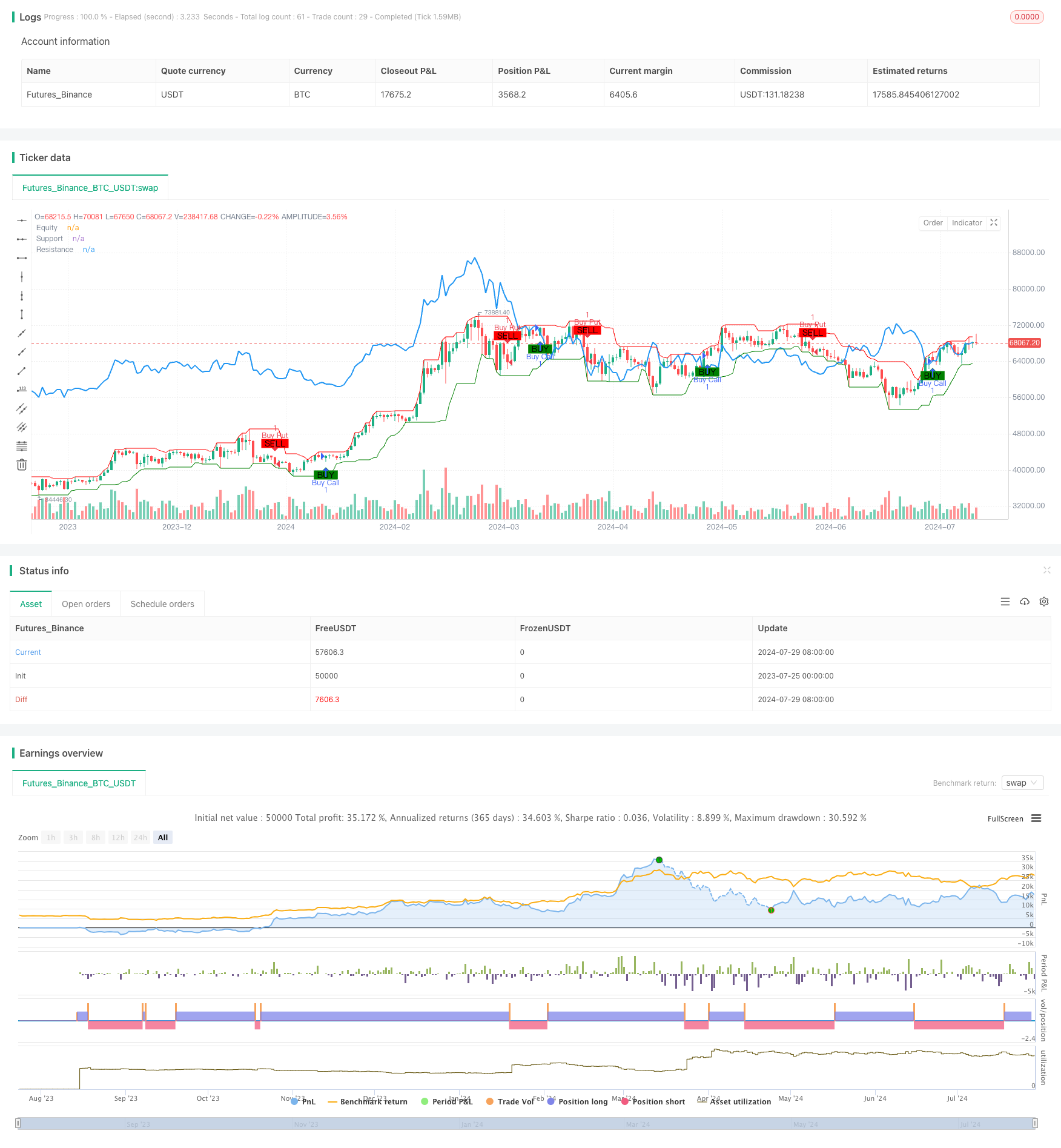
概述
本策略是一个结合了支撑阻力线、移动平均线交叉和价格突破的综合性交易系统。它利用短期和长期移动平均线的交叉来确定市场趋势,同时通过动态支撑阻力线来识别关键价格水平。当价格突破这些关键水平并且均线发出信号时,策略会执行买入或卖出操作。这种方法旨在捕捉市场的趋势性变化,同时通过多重确认来降低虚假信号的风险。
策略原理
移动平均线交叉:策略使用9期和21期简单移动平均线(SMA)。当短期SMA上穿长期SMA时,视为看涨信号;当短期SMA下穿长期SMA时,视为看跌信号。
动态支撑阻力线:使用9期内的最低价和最高价分别计算动态支撑位和阻力位。这些水平随着市场波动而不断调整,提供了更贴近当前市场状况的参考点。
价格确认:除了均线交叉,策略还要求价格位于关键水平之上或之下。具体而言,买入信号需要收盘价高于支撑位,而卖出信号需要收盘价低于阻力位。
信号生成:只有当均线交叉和价格确认同时满足时,策略才会生成交易信号。这种多重确认机制有助于减少虚假信号。
交易执行:在买入信号出现时,策略进入多头;在卖出信号出现时,策略进入空头。同时,策略也会在相反信号出现时平仓已有的头寸。
策略优势
多重确认机制:通过结合移动平均线交叉和价格突破,策略降低了误报的可能性,提高了交易的可靠性。
动态适应市场:使用动态支撑阻力线使策略能够适应不同的市场环境,无论是趋势市场还是震荡市场。
趋势跟踪:移动平均线交叉有助于捕捉中长期趋势,使策略能够在强劲的市场走势中获利。
风险管理:通过在相反信号出现时及时平仓,策略内置了一定的风险控制机制。
视觉化:策略在图表上标注了支撑阻力线和交易信号,便于交易者直观地理解市场动态和策略逻辑。
策略风险
震荡市场中的频繁交易:在横盘震荡的市场中,移动平均线可能会频繁交叉,导致过多的交易和不必要的手续费损失。
滞后性:移动平均线本质上是滞后指标,可能在趋势反转的初期阶段错过交易机会。
假突破风险:价格短暂突破支撑阻力线后又回落的情况可能导致虚假信号。
缺乏止损机制:当前策略没有明确的止损设置,在极端市场环境下可能面临较大风险。
过度依赖技术指标:策略完全基于技术指标,忽视了基本面和市场情绪等其他重要因素。
策略优化方向
引入波动性过滤器:可以考虑加入ATR(平均真实波幅)指标,在市场波动较大时调整交易参数或暂停交易,以应对不同的市场环境。
优化移动平均线参数:可以尝试使用指数移动平均线(EMA)或其他类型的移动平均线,以减少滞后性。同时,可以通过回测优化移动平均线的周期。
加入趋势强度确认:引入RSI(相对强弱指数)或ADX(平均趋向指标)等指标,只在趋势明确时执行交易,以减少震荡市场中的虚假信号。
实施更严格的入场条件:可以要求价格不仅突破支撑阻力线,还需要保持一定距离或持续一定时间,以过滤掉短期的假突破。
加入止损和获利了结机制:设置基于ATR或固定百分比的止损点,同时引入移动止损或基于支撑阻力线的获利了结机制,以更好地控制风险和锁定利润。
考虑成交量因素:将成交量作为交易信号的额外确认,只有在成交量配合的情况下才执行交易,以提高信号的可靠性。
优化支撑阻力线计算:可以尝试使用更长期的高低点或结合斐波那契回调水平来确定更有意义的支撑阻力位。
引入时间过滤:考虑市场的时间特性,例如避开开盘和收盘前的波动期,或者只在特定的交易时段内执行策略。
总结
动态支撑阻力突破均线交叉策略是一个综合了多个技术分析概念的交易系统。通过结合移动平均线交叉和动态支撑阻力线,该策略旨在捕捉市场趋势的变化,同时通过多重确认机制来提高交易信号的可靠性。虽然策略具有适应性强、风险控制内置等优势,但仍面临震荡市场频繁交易、滞后性等挑战。
为了进一步优化策略,可以考虑引入波动性过滤器、优化移动平均线参数、加入趋势强度确认等方法。同时,加入更严格的入场条件、完善止损和获利了结机制,以及考虑成交量因素,都可能显著提高策略的有效性。
最后,重要的是要认识到,没有一个策略是完美的或适用于所有市场环境的。交易者在使用此策略时,应结合自身的风险承受能力和市场洞察力,不断进行回测和优化,以适应不断变化的市场条件。同时,将此策略作为整体交易系统的一部分,结合其他分析方法和风险管理技巧,才能在金融市场中取得长期稳定的收益。
/*backtest
start: 2023-07-25 00:00:00
end: 2024-07-30 00:00:00
period: 1d
basePeriod: 1h
exchanges: [{"eid":"Futures_Binance","currency":"BTC_USDT"}]
*/
//@version=5
strategy("Bank Nifty Intraday Strategy", overlay=true)
// Input parameters
shortPeriod = input.int(9, title="Short Moving Average Period")
longPeriod = input.int(21, title="Long Moving Average Period")
resistanceColor = input.color(color.red, title="Resistance Line Color")
supportColor = input.color(color.green, title="Support Line Color")
lineWidth = input.int(1, title="Line Width", minval=1, maxval=5)
buySignalColor = input.color(color.green, title="Buy Signal Color")
sellSignalColor = input.color(color.red, title="Sell Signal Color")
// Calculate moving averages
shortMA = ta.sma(close, shortPeriod)
longMA = ta.sma(close, longPeriod)
// Detecting Support and Resistance
support = ta.lowest(low, shortPeriod)
resistance = ta.highest(high, shortPeriod)
// Plotting support and resistance lines
plot(support, color=supportColor, linewidth=lineWidth, title="Support")
plot(resistance, color=resistanceColor, linewidth=lineWidth, title="Resistance")
// Buy and Sell signals based on crossover and crossunder
buySignal = ta.crossover(shortMA, longMA) and close > support
sellSignal = ta.crossunder(shortMA, longMA) and close < resistance
// Plotting Buy and Sell signals
plotshape(series=buySignal, title="Buy Signal", location=location.belowbar, color=buySignalColor, style=shape.labelup, text="BUY", size=size.small)
plotshape(series=sellSignal, title="Sell Signal", location=location.abovebar, color=sellSignalColor, style=shape.labeldown, text="SELL", size=size.small)
// Execution logic for strategy
if (buySignal)
strategy.entry("Buy Call", strategy.long)
if (sellSignal)
strategy.entry("Buy Put", strategy.short)
// Exit conditions
if (strategy.opentrades > 0)
strategy.close("Buy Call", when=sellSignal)
if (strategy.opentrades < 0)
strategy.close("Buy Put", when=buySignal)
// Plotting profit and loss on chart
plot(strategy.equity, title="Equity", color=color.blue, linewidth=2)